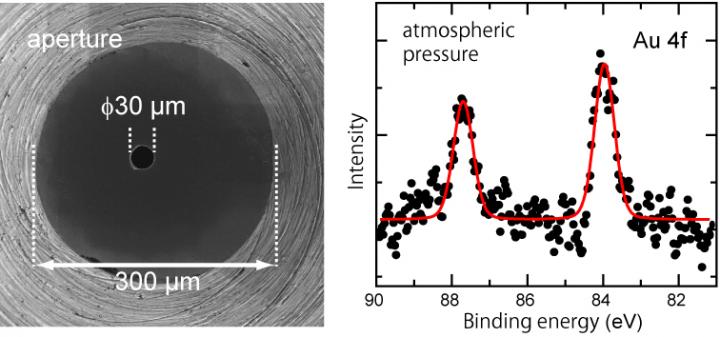
X-Ray Photoelectron Spectroscopy: Insights Under Ambient Pressure

(left) This is a picture of a front cone, a circular cone-shaped spectrometer component, taken from above. The 30 μm aperture created at the tip is the port where photoelectrons enter the spectrometer. (right) The peaks represent the photoelectron spectroscopic signals of gold thin film detected under atmospheric pressure of air.
Credit: INSTITUTE FOR MOLECULAR SCIENCE
Conventional photoelectron spectroscopy can only measure samples under high vacuum, while many catalytic reactions occur under atmospheric pressure. The discrepancy between the findings obtained by experiments under high vacuum and the actual reaction mechanism under atmospheric pressure, “pressure gap,” has been an issue.
In recent years, in order to fill this gap, an apparatus called “ambient pressure photoelectron spectroscopy” has been developed that enables measurement under gas atmosphere. However, the upper-pressure limit of operation in a general ambient pressure photoelectron spectrometer is approximately 5,000 Pa.
Even the apparatus with a currently reported world's highest performance has a limit of 15,000 Pa (approx. 0.15 atm), which is about 1/7 the atmospheric pressure (approx. 100,000 Pa). Therefore, various research groups in the world have been working on the development of photoelectron spectroscopy that operate under higher gas pressure.
A problem upon measurement using ambient pressure photoelectron spectrometer is “energy decay” of the photoelectrons emitted from the sample exposed to light, which is due to scattering caused by gas. This limits the upper-pressure of the measurement.
“We made two improvements,” explains Yasumasa Takagi, an assistant professor of IMS. “First, we used hard X-rays that has higher energy compared to soft X-rays and boosted kinetic energy of the photoelectrons. Next, we created an extremely tiny aperture of 30 μm in diameter (figure left), which is a port that accepts photoelectrons into the spectrometer.
This enabled to shorten the distance between the sample and the aperture, i.e. the distance of photoelectron traveling through gas has shortened.” Thus, using gold thin film as a sample, the research group succeeded in photoelectron spectroscopy under real atmospheric pressure, for the first time in the world (figure right).
Professor Toshihiko Yokoyama (IMS) has a vision of possibilities for future applications of the novel photoelectron spectrometer. “Our apparatus achieved photoelectron spectroscopy under real atmospheric pressure, which greatly broadened its range of application. Reactions between solid and gas such as catalytic reactions and electrode reactions in fuel cells can be directly examined under atmospheric pressure. It can be also applied to biological samples that are fragile under high vacuum. In the future, photoelectron spectroscopy will be used for state analysis in various research areas.”
###
This research was supported by the Grants-in-Aid for Scientific Research (KAKENHI) from the Japan Society for the Promotion of Science and by the Polymer Electrolyte Fuel Cell Program from the New Energy and Industrial Technology Development Organization (NEDO) Project.
*1 Soft X-rays / hard X-rays
Electromagnetic waves in the wavelength range of 1 pm to 10 nm are called X-rays. Those of long wavelengths are called soft X-rays and those of short wavelength are called hard X-rays. The shorter the wavelength, the higher the energy of the electromagnetic waves.
*2 SPring-8
SPring-8 is the world's largest synchrotron radiation facility, located in Harima Science Park, Hyogo Prefecture, Japan. It is managed by RIKEN and operated by JASRI. Synchrotron radiation refers to narrow and powerful electromagnetic waves that are produced when electrons are accelerated to nearly the speed of light and their traveling direction is bent by electromagnets. Synchrotron radiation from SPring-8 is widely used for nanotechnological, biotechnological, and industrial studies.
*3 Photoelectron spectroscopy
Method to observe conditions of a material by measuring the energy of photoelectrons emitted owing to the photoelectric effect when the material is irradiated with electromagnetic waves.















